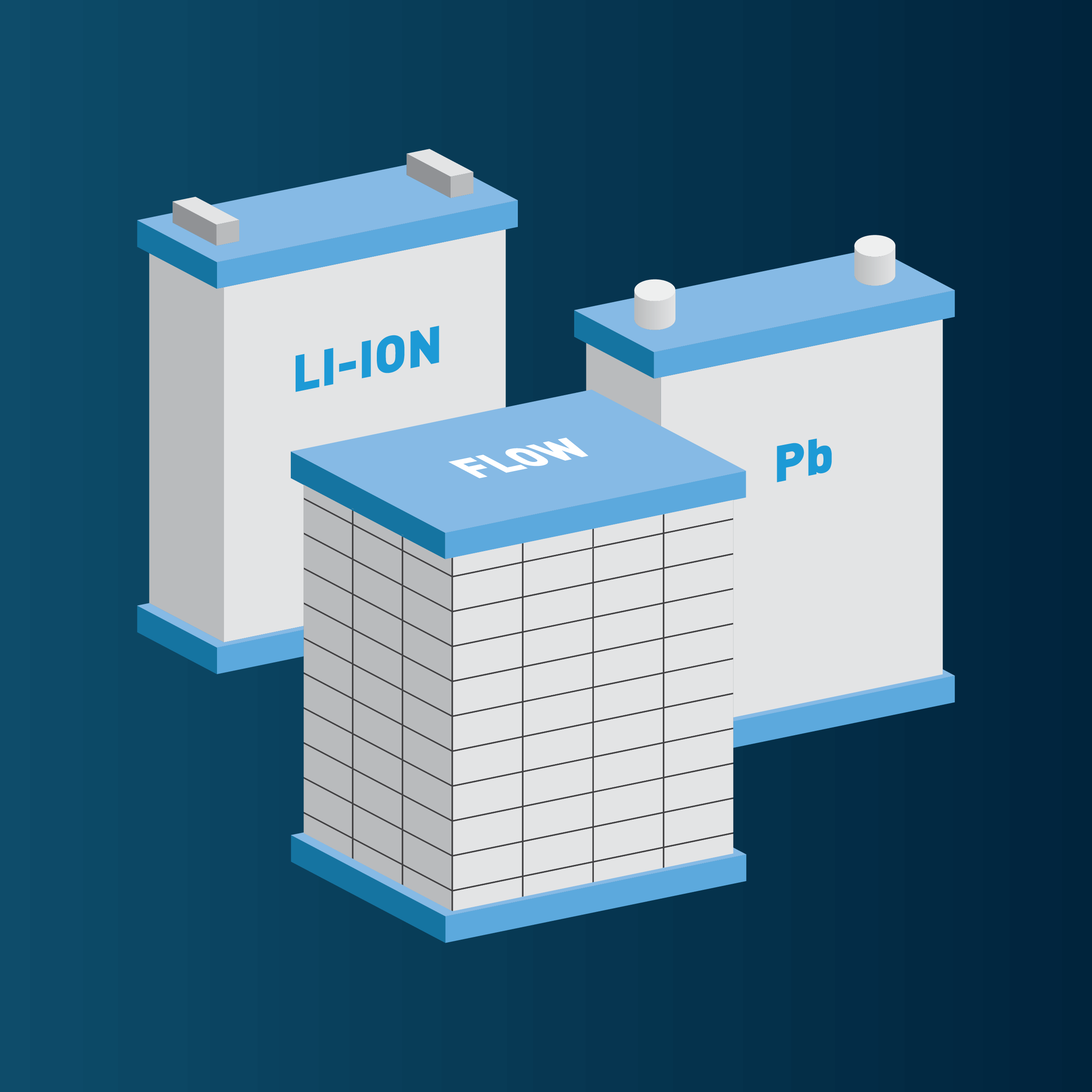
When looking at solar energy storage, you’ll find several types of solar batteries available. These batteries are growing in popularity because they help with high utility costs, environmental concerns, and disaster readiness. This blog will explore three of the most common solar battery storage technologies, benefits of solar battery storage, and how to choose the best one.
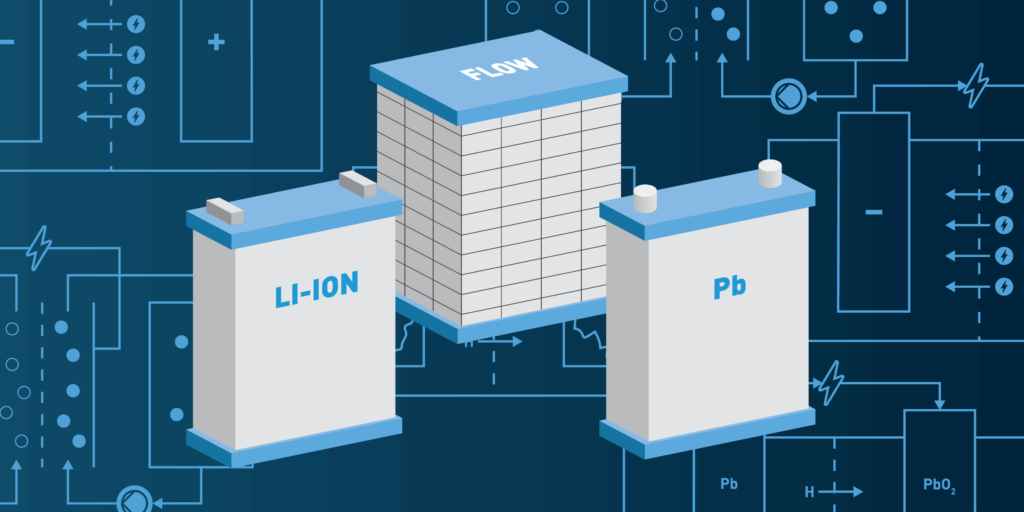
Types of Solar Batteries
The three most common solar battery options are:
- Lithium-Ion Batteries
- Lead-Acid Batteries
- Flow Batteries
Different types of solar batteries come with their own set of advantages and drawbacks, making them ideal for different homeowners based on their budget, location, and energy needs. Some batteries are highly efficient, long-lasting, and require little maintenance, but they often come at a higher price. On the other hand, more affordable options may have a shorter lifespan and require regular upkeep. For homes with larger solar panel systems, a battery with greater storage capacity and longer discharge times may be the best fit, while smaller homes may not be as worried about the capacity of their battery. Climate also plays a role—batteries that perform well in extreme temperatures are better suited for regions with harsh weather conditions.
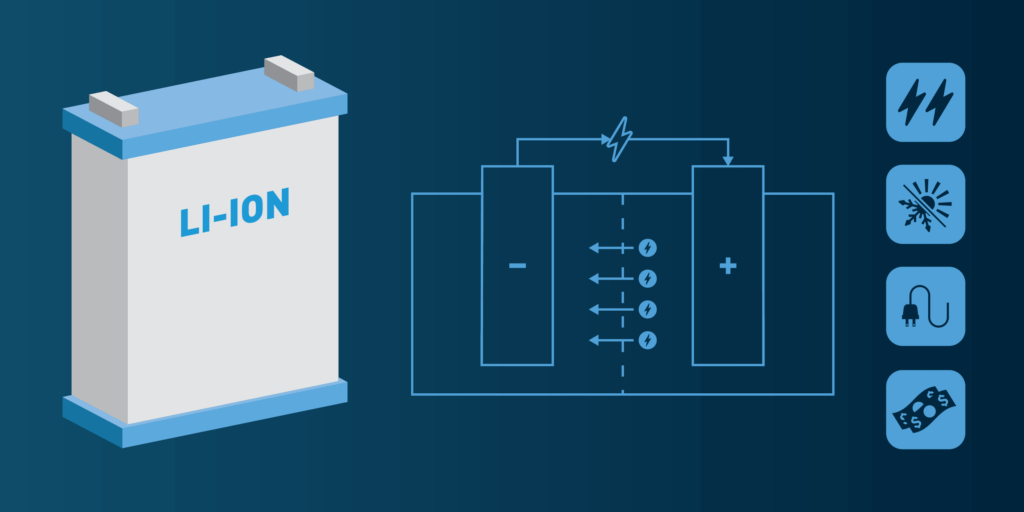
Lithium-Ion Batteries
Lithium-ion solar batteries, like those in smartphones, work by moving lithium ions between two electrodes: the anode (usually made of graphite) and the cathode (often made of lithium metal oxide). During discharge, lithium ions move from the anode to the cathode through an electrolyte, releasing energy.
The discharge process is the same for solar lithium-ion batteries too. During the day, solar panels convert sunlight into electricity, which can be used immediately or directed to charge the lithium-ion battery, until the battery is full. The battery stores this electrical energy in the form of chemical energy within its lithium-ion cells. After the battery is completely charged, excess energy that is generated is sent back to the grid. When solar energy production is low, such as during the night or on cloudy days, the battery releases stored energy to power devices.
This solar battery offers extended durability, minimal maintenance, and is a top pick for homeowners looking to enhance the efficiency and longevity of their solar energy systems.
Advantages:
- High Energy Density: One of the key advantages of lithium-ion batteries is the high energy density, meaning they can store a large amount of energy in a relatively small and lightweight structure. This allows homeowners to maximize their space without compromising on storage.
- Fast-Charging Rate and High-Power Output: Lithium-ion batteries can accept more charge current, resulting in a faster charge.
- Requires Minimal Maintenance: Lithium-ion batteries have a lower self-discharge rate compared to lead-acid batteries, requiring minimal, routine maintenance.
Disadvantages:
- Higher Initial Cost: In most cases, lithium-ion batteries are more expensive, averaging anywhere from $10,000-$15,000.
- Safety Risks: Lithium-ion batteries installed improperly can self-heat, often without stopping, in a process called thermal runway. The chance of thermal runway is low when partnering with an experienced solar installation company, but safety risks are still a drawback for some homeowners.
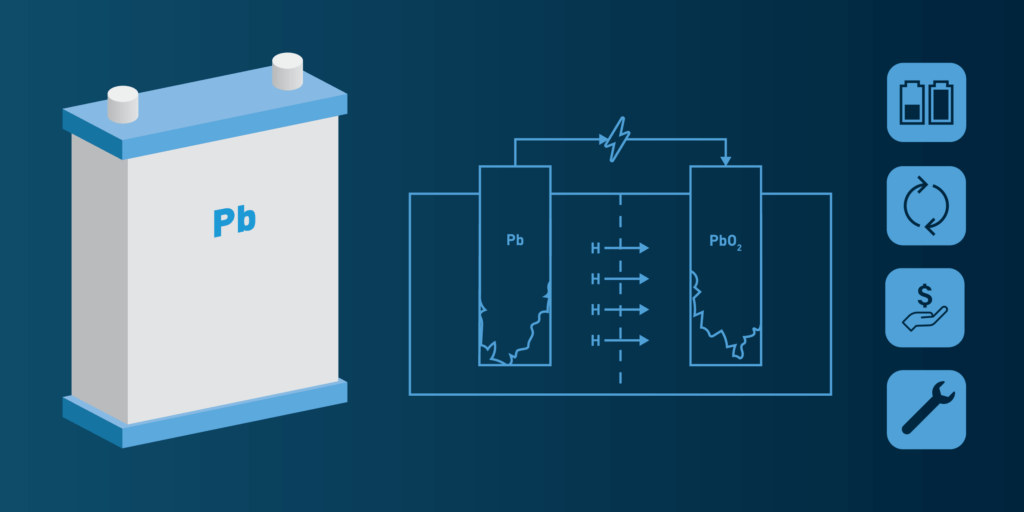
Lead-Acid Batteries
Lead-acid batteries store and release energy through a simple chemical reaction. Inside the battery, there are two types of lead plates—lead dioxide and sponge lead—immersed in a sulfuric acid solution. When the battery gives power, the lead plates mix with sulfuric acid, forming lead sulfate and water, which releases energy. When recharged, the electric current reverses this, turning lead sulfate back into lead dioxide, sponge lead, and sulfuric acid. This back-and-forth reaction allows the battery to be used repeatedly.
While this type of solar battery is more budget-friendly than a lithium-ion battery, it falls short in energy density and cycle life. This type of solar battery also requires regular maintenance, as hazardous hydrogen gases can accumulate without proper ventilation.
Advantages:
- Constant Discharge Rate: Battery discharge indicates how much of the battery has been used during a single cycle. When fully charged, the full depth of discharge (DoD) is 100%.
- Cost Effective: Lead-acid batteries are more affordable because they use widely available materials like lead and sulfuric acid, which keeps production costs low. Additionally, their simple design and long-established manufacturing processes contribute to lower overall expenses compared to newer battery technologies.
- Deep Cycling: Lead-acid batteries produce a steady output of energy over a long period of time, in a process known as deep cycling. Lead-acid batteries fall into the category of deep cycle batteries and are available in several different voltages and capacities.
Disadvantages:
- Shorter Lifespan: The lifespan of a lead-acid battery is between 4-7 years, depending on specific battery brand, type, usage, and maintenance. On average, lead-acid batteries have half the lifespan of other solar battery types.
- Bulkier Size and Weight: Lead-acid batteries tend to be bulky and heavier than lithium-ion batteries and take up more space.
- Requires Regular Maintenance: Regular maintenance by professionals is required to keep lead-acid batteries performing optimally.
- Old Technology: The technology found in lead-acid batteries has been in use since 1859. Since then, solar battery technology has advanced, leaving lead-acid technology behind.
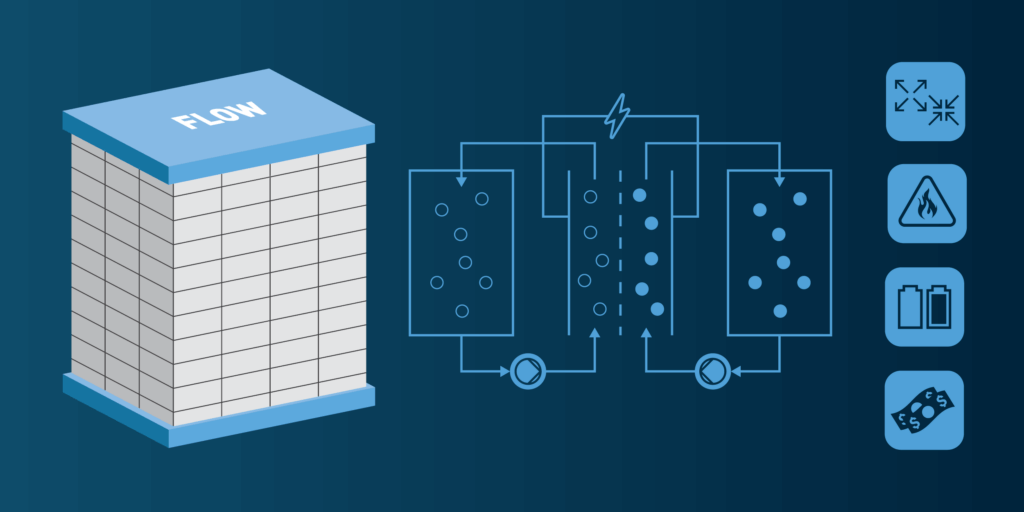
Flow Batteries
Modern flow batteries are new to the solar industry, introduced in 1973. Flow batteries store and release energy through the movement of liquid electrolytes between two tanks, separated by a membrane within the battery cell. The electrolytes within the tanks, typically containing metal ions, flow through the cell, where a chemical reaction occurs, facilitating the transfer of electrons and generating an electric current. This process is reversible, allowing the battery to be recharged by reversing the flow and restoring the original chemical states of the electrolytes. This design enables easy scalability by adjusting the size of the electrolyte tanks, but storing a practical amount of electricity requires the tanks to be quite large.
Advantages:
- Scalability: Flow batteries are easy to scale, and manufacturers can easily make them larger by increasing the electrolyte solution’s volume, as well as the tank sizes. This can also potentially increase cycle times compared to traditional battery chemistries, as the energy is stored outside of the cell.
- Deep Discharges: A deep battery discharge refers to how much the battery has been drained compared to its total capacity. Flow batteries can be fully discharged to 100% without harming the electrolyte fluid. This capability may contribute to a longer lifespan for these batteries, as high discharge rates can otherwise reduce their longevity.
- Little to No Risk of Thermal Runaway: Flow batteries are primarily made of water mixed with electrolytes, which is not flammable. This means they are safer than other types of batteries used with solar energy systems.
Disadvantages:
- Higher Cost: Currently, only a few companies install flow batteries, resulting in limited demand. They are not commonly chosen for use with solar panel systems, mainly due to their lower energy density compared to lithium-ion batteries.
- Bulky Size: Flow batteries require additional components such as pumps and tanks to circulate electrolytes. To store the same amount of electricity as a smaller lithium-ion battery, flow batteries must be larger because they use liquid electrolytes housed in tanks, which occupy more space. While flow batteries are scalable and ideal for long-duration storage, they demand more physical space compared to the compact design of lithium-ion batteries.
- Little to No Availability for Residential Purchases: Flow batteries are still in the early stages of production. Due to their space requirements, this type of solar battery is not ideal for residential solar owners.
Why Use Solar Batteries?
Pairing your solar panel system with a battery or other home storage solution comes with many benefits. It can enhance your energy independence by allowing you to store and use the electricity generated by your solar panels, rather than relying solely on the utility grid. They can also provide energy at night when solar panels generate less electricity, which helps lower energy costs and enhances overall energy efficiency.
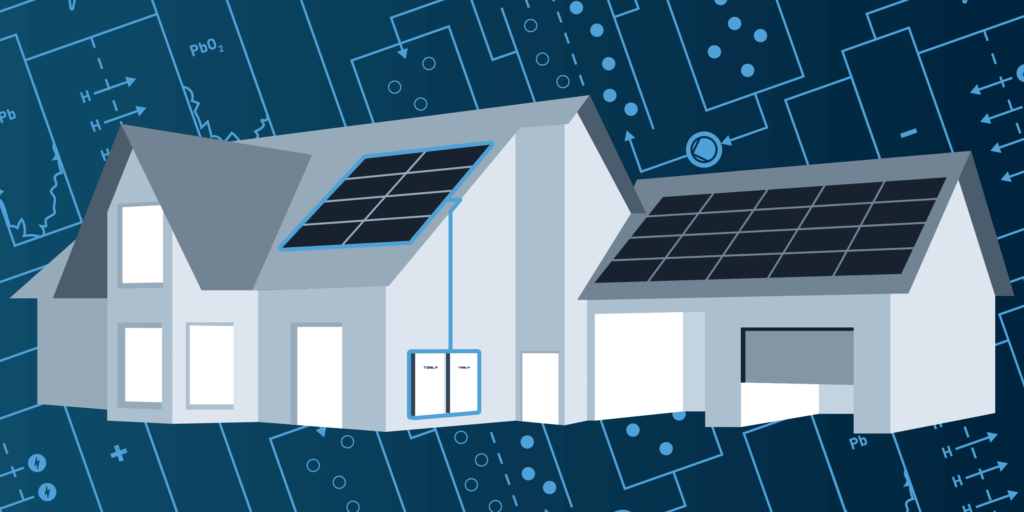
The Best Solar Battery to Install at Your Home
Choosing the right solar battery depends on your budget, energy goals, compatibility with your solar panel system, and available space.
The most popular type of solar battery for those who have rooftop solar panel systems is the lithium-ion battery, due to their high energy density, long cycle life, and enhanced safety features.
To find the best type of solar battery to add to your home, consult with a reliable, local solar installer, like Blue Raven Solar.
Partner with Blue Raven Solar Today
At Blue Raven Solar, we seamlessly integrate solar batteries into your existing PV system, maximizing both energy independence and savings.
Whether you’re already enjoying the benefits of a Blue Raven Solar rooftop system or are just beginning your solar journey and considering a battery storage solution, we’re here to guide you every step of the way.
For homeowners new to solar, we can install batteries alongside your solar panels to ensure optimal financial and energy benefits.
Reach out to our solar experts today to learn more!



Sorry, the comment form is closed at this time.